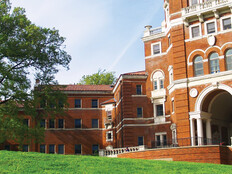Deploying Campuswide Wi-Fi Upgrades
Over the course of the eight-month, $11 million upgrade project, UMich has implemented over 15,000 Aruba AP-635 indoor model Wi-Fi 6E access points. Getting there was no small task.
“We had to have partnerships across the entire university. When you talk about residence halls, people are living there. We can’t just knock on the door and tell students, ‘We are here to replace your access point.’ That has to be coordinated with our student housing office,” Pendse says. “If the access points are in classrooms, we have to coordinate with the registrar’s office to make sure that no class is being taught when we go in.”
The IT team coordinated with facilities managers, who helped them pin down the locations of hard-to-reach access points (hidden in the ceiling, for example) and who also helped to coordinate building activities to ensure a seamless rollout.
RELATED: Stadium Wi-Fi connectivity enhances the college sports fan experience.
“We worked over the weekend, over the spring break and the holidays. It requires lots of organizations and lots of people coming together,” Pendse says.
Continuity of service was a major consideration — ensuring uninterrupted access even as the hardware was being switched out.
“A lot of that was about managing the supply chain, working with our vendor partner to time when the access points would arrive,” Pendse says. “In addition, the new access points that we’re deploying were set up in a way that, as soon as we connect them to the network, they would self-configure and start providing service immediately.”
When you’re deploying over 15,000 of them, “that could take a really long time to set up without some level of automation,” he says.
DISCOVER: A checklist for closing the broadband gap.
How Stronger Wi-Fi Drives Academic Outcomes
The modernized Wi-Fi connectivity helps to support a number of key academic needs across the university.
Faculty members are taking the techniques that worked well during COVID-19 and bringing them back into the classroom — for example, having students collaborate via Zoom when in large auditoriums. To make that work, “they are leveraging the Wi-Fi to enhance teaching and learning,” Pendse says.
The enhanced connectivity supports special projects too, like the new Ford Robotics Building, built in collaboration with Ford Motor Company. “We have robots in that building, and these robots need to connect to the network. With our new network, they are able to get the kind of bandwidth they need to get things done,” says Pendse.
In the long term, the upgrade effort, which was funded as a capital project with support from university leadership, could also help trim the IT budget, even as it supports other key university ambitions.
EXPLORE: How to bring Wi-Fi connectivity to rural, tribal colleges.
“People are getting download speeds of upward of 300 to 400 megabits per second, which allows us reduce the number of wired ports that we have across the campus and reduce the number of switches in all of our closets,” Pendse says. “You’re talking about almost 80,000 wired ports being removed or reduced. That saves us several thousand switches in the closets.”
Besides the hardware costs, fewer switches also means less electronic waste, less power consumption and less heat generated. “All this helps with our overall sustainability goals,” he said.
Looking ahead, the IT team is strategizing ways to leverage the more robust Wi-Fi in support of improved end-user experiences. “Wi-Fi 6E will allow us to enable consumer-grade devices — Alexa, Apple TV, all these devices for personal and classroom needs. We are rolling that out so that it will be just plug and play,” Pendse says.











